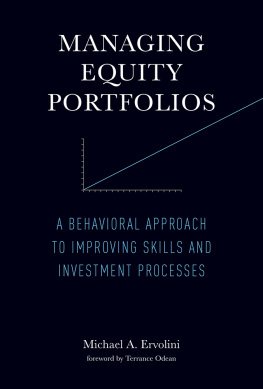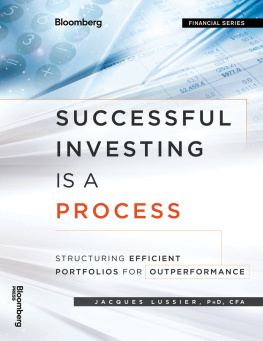Managing Equity Portfolios
Managing Equity Portfolios
A Behavioral Approach to Improving Skills and Investment Processes
Michael A. Ervolini
Foreword by Terrance Odean
The MIT Press
Cambridge, Massachusetts
London, England
2014 Michael A. Ervolini
All rights reserved. No part of this book may be reproduced in any form by any electronic or mechanical means (including photocopying, recording, or information storage and retrieval) without permission in writing from the publisher.
Library of Congress Cataloging-in-Publication Data
Ervolini, Michael A., 1955
Managing equity portfolios : a behavioral approach to improving skills and investment processes / Michael A. Ervolini ; foreword by Terrance Odean.
p. cm.
Includes bibliographical references and index.
ISBN 978-0-262-02834-9 (hardcover : alk. paper)
ISBN 978-0-262-32302-4 (retail e-book)
1. Portfolio management. 2. InvestmentsPsychological aspects. I. Title.
HG4529.5.E78 2014
332.6322dc23
2014013234
d_r1
To Carol, for filling my life with Joy.
Foreword
Terrance Odean
In 1995, Don Keim and Ananth Madhavan published a study of 62,000 equity orders placed by 21 institutional investors. Three of the institutions were indexers. Of the remaining 18 active managers, 15 sold stocks that, on average, had outperformed the market the week before the sale. This finding was hardly puzzling if managers used price targets to trigger trades. What surprised Keim and Madhavan was that some traders appear to adopt different strategies on the buy and sell sides. Six of the managers who were selling recent winners were also buying recent winners, and two of the three who were selling recent losers were also buying recent losers. Keim and Madhavan wrote: The asymmetry between buy- and sell-side behavior is difficult to explain. This could reflect the use of complex, nonlinear trading strategies that are not readily apparent from an examination of the data.
The dominant academic paradigm of the time was that economic agentsespecially professionalsalways behaved sensibly. If money managers bought stocks very similar to the ones they sold, a goodif not obviousexplanation had to exist. Even today, normative corporate finance theories are confirmed by showing that corporate behavior is consistent with the theory. When the two diverge, the presumption is that the theory is wrong rather than that the behavior is suboptimal.
At the time that Keim and Madhavans paper was published, I was analyzing the trading records for 10,000 individual investors at a large discount brokerage. I found that, like the institutional investors who puzzled Keim and Madhavan, individual investors have a strong tendency both to sell and buy stocks that have outperformed the market over the previous week (or month, or year). I was, though, trying to test behavioral theories of investor behavior and thus was not surprised by apparent inconsistencies in buying and selling strategies. I wrote, While theoretical models of financial markets often treat buying and selling symmetrically, for most investors the decision to buy a security is quite different from the decision to sell. Buyers face a huge search problem: in equity markets alone, there are thousands of stocks to choose from, and yet sellersespecially individualsusually choose from the few stocks they already own. In other respects, though, selling is more complicated. Buyers care only about future performance, yet sellers must consider not only the future but the past. Selling a past winner may trigger a tax bill; selling a past loser may cause regret. For many investors, buying is a forward-looking activity and selling is backward-looking.
The tax consequences of selling create an opportunity to pit normative economic theories against behavioral theories based on research in psychology. Tax theory predicts that investors will usually sell losing stocks so as to minimize taxes. Psychology predicts that investors will hang on to their losers and sell winners, a tendency that Shefrin and Statman (1985) term the disposition effect. I found that the individual investors in my dataset tended to sell winners and hold losers. Only in December did tax-loss selling dominate.
Weve learned a great deal about individual investors in the past 19 years. Studies have found that individual investors exhibit a disposition effect for many different assets and in many different countries. (See Barber and Odean 2013 for a review.) Individual investors trade more than is in their best interests. The stocks they buy subsequently tend to underperform the ones they sell. The more actively they trade, the worse they do. Men, who tend to be more overconfident about investing than women, trade more actively than women. Active trading reduces portfolio returns for both men and women, but men lose more because they trade more. The cost of excessive trading can be substantial. Including commissions and taxes, the aggregate trading costs of individual investors in Taiwan from 1995 through 1999 were equivalent to 2.2% of GDP!
Individual investors underdiversify. They pay too little attention to fees. They chase past performance. They buy attention-grabbing stocks. They purchase stocks theyve owned before if they made money the first time and if the stock has gone down since they sold it. They tend to buy the same stocks as each other and sell the same stocks as each other. They prefer stocks with lottery-like distributions and trade less when they can buy lottery tickets and when the lottery payoffs are high. Investment performance goes up with IQ and down with age. And investors who get more speeding tickets also trade more.
One reason that weve learned a lot about individual investor behavior is that researchers have found many rich sources of data, including brokerage firms in China, Germany, Israel, the United States, and Sweden; stock exchanges in Australia, China, Finland, Norway, India, and Taiwan; and government agencies in Finland, Sweden, and Norway.
So far, the psychology of institutional investors has been studied less than that of individual investors. While fewer sources document the trading activities of institutional investors, a lack of data is not the only impediment to understanding the behavior of institutional investors. Individual investors who trade without professional advice make decisions about their own money, whereas institutional investors make decisions about other peoples money. But these same decisions will, in many cases, affect the institutional investors own compensation and future employment opportunities. So an institutional investors behavior depends both on what is best for the client and what is best for the investor himself or herself.
Thus, a money managers behavior will be influenced by how his or her performance is measured, monitored, and rewarded. And these incentives sometimes lead to unintended consequences. For example, fund managers engage in window dressingselling poorly performing stocks prior to being monitored by plan sponsors (Lakonishok, Shleifer, Thaler, and Vishny 1991); managers increase risk in the second half of the year when their performance is below a benchmark and decrease it when above (Brown, Harlow, and Starks, 1996); and hedge funds that have built up less reputation value take more risks than their peers and are more likely to fail (Brown, Goetzmann, and Park, 2001).
While incentives play a large role in explaining money manager behavior, so too do the biases and limitations of human decision-making. Money managers, like the rest of us, are prone to biased estimates of probability, to overconfidence, and to loss aversion. They, too, have limited attention and emotions that distort decisions. Managers who are unaware of their own biases are likely to make trades that enhance neither their own welfare nor that of their clients.
Next page








